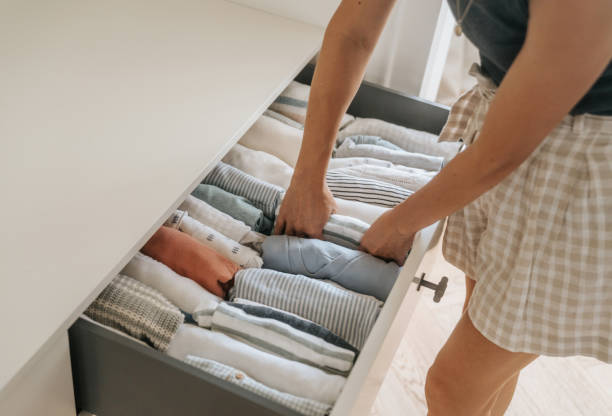
Let’s face it, decluttering clothes can often feel like a daunting challenge, especially when every item seems to hold a memory or purpose. But what if we told you that becoming more ruthless in your approach isn’t only liberating but also essential for reclaiming your space and peace of mind? This article will unveil the main topic of ruthless decluttering – a strategy that assists in making those tough decisions to let go and refresh your wardrobe. By practicing the methods suggested here, you will not only have a tidier closet but getting started could also lead to a newfound sense of clarity and lightness within your living space.

Preparing for the Purge: Mindset and Motivation
The first step in embarking on the journey of ruthless decluttering is cultivating the right mindset. Acknowledge that you are not only sorting out clothes; you are curating your wardrobe for a more functional and joyful existence. Being more ruthless means having the willingness to part with items that have not been worn and accepting that having too many options can often add unnecessary stress. Visualize the wardrobe space you’ve always desired and let that image drive your decluttering process. Set clear goals for what you wish to achieve – whether it’s reducing your closet by half or ensuring everything fits into a specific space. Emotions often cloud our decluttering efforts, but remember, being ruthless does not mean discarding memories or value; it means giving precedence to the quality and utility of the present over the past.
A Step-by-Step Guide to Ruthlessly Declutter Your Closet
Starting decluttering may seem overwhelming, but breaking it down into steps will make the process easier. Begin by taking out every piece of clothing you own and laying them out. This could also serve as an eye-opening experience to the volume of items in your possession. Below are the steps to follow:
- Assemble and categorize your clothing: Group your clothes by type, like pants with pants, shirts with shirts. This organization will help you process each category without feeling overwhelmed.
- Assess each item with critical questions: Hold each piece of clothing and ask, “”Have I worn this in the past year?””, “”Does it bring me joy or is it necessary?””, and “”Would I buy it now?””.
- Try on questionable items: If you’re not sure about an item, try it on. If it doesn’t fit or you don’t feel good in it, it’s time to let go.
- Apply the one-year rule: If you haven’t worn an item in over a year, chances are you don’t need it. Exceptions could include special occasion wear or seasonal items.
- Eliminate duplicates and prioritize quality: Keep the pieces that serve you best in terms of fit and quality. Multiple similar items can clutter your space.
- Address ‘just in case’ syndrome: It’s easy to hold onto things for hypothetical scenarios. If these scenarios have not arrived within a year, it’s time to donate or sell.
Strategies for Decluttering Difficult Categories
There are always certain items that seem harder to part with. Sentimental pieces, expensive garments, and gifts often lay unworn because we’re not ready to deal with the emotions or guilt they bring. Adopt a more ruthless stance by reflecting on the utility the item offers in your life now, not in the past or future. If an item was a gift, honor the sentiment but not at the expense of your space. Expensive items can be sold or repurposed, transforming their value into something that you will use or appreciate more. As for sentimental items, consider taking photos of them or incorporating them into something new, like a quilt or artwork, so the memory stays with you in a more practical form.

Overcoming Common Obstacles in Clothing Decluttering
One of the biggest obstacles faced during the wardrobe decluttering process is guilt associated with waste or spending. Re-frame your perspective by recognizing the value of freeing space and the opportunity for the items to serve someone else. For those with weight variations, maintain a capsule of transitional items and stay hopeful about future changes. And when it comes to shifting seasons, rotate wardrobe staples and store the rest properly to avoid cramming everything into your daily space. Remember, being ruthless with decluttering also means being compassionate with yourself. The goal is to create a space that reflects your needs and style now, not to hold onto what was or could be.
What to Do With the Discarded Clothes
Once you’ve separated the clothes you’ll keep from the ones to discard, it’s time to decide what to do with them. Here’s a simple table that may help organize your next steps:
| Action | Best for | Tips |
|---|---|---|
| Donate | Clothes in good condition not likely to sell | Research local charities and donation centers; some may have specific clothing needs. |
| Sell | Brand name or high-value items | Use online platforms or consignment shops and ensure items are clean and well-presented. |
| Recycle | Damaged or worn-out items | Look for textile recycling programs or consider creative ways to reuse the fabric yourself. |

Conclusion
The process of ruthless decluttering can initially stir a range of emotions but it often ends with a sense of accomplishment and relief. It is transformative, not only for your closet but also for your daily routine and mental clarity. Keeping up with the decluttered wardrobe requires regular checks and balances, but once you’ve felt how good it is to have a curated collection of clothes, the effort to maintain it becomes a worthwhile habit. Through the methods outlined, your journey to a decluttered, organized wardrobe will also pave the way for more intentional living across all aspects of your life.
Frequently Asked Questions
Let’s address some common queries that arise when it comes to decluttering clothes.
- How frequently should I declutter my wardrobe? Ideally, decluttering seasonally will help maintain a current and manageable wardrobe. At the very least, a thorough declutter should be done annually.
- How do I decide which clothes to keep when I have emotional attachments to them? Ask yourself if the item is currently bringing you joy or utility. If not, it may be time to let go and allow someone else to appreciate the item.
- What is the best way to store clothes that I want to keep but don’t wear often? Use transparent, airtight bins to protect your clothes from dust and pests and store them in a place where they won’t hinder your daily clothes selection.
- How do I resist the urge to buy more clothes after decluttering? Implement a one-in-one-out rule, wait a few days before purchasing to avoid impulse buys, and focus on filling gaps in your wardrobe rather than accumulating more.
- What should I consider when deciding to sell or donate clothes? Consider the condition and potential value of your items. Selling may bring in some money, but donating can be quicker and just as satisfying, knowing your clothes are going to a new home.




